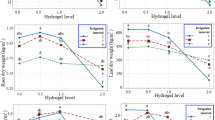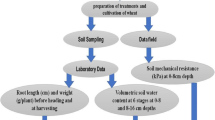Abstract
Drought is one of the major environmental stress factors limiting sugarcane production. Under rainfed conditions, sugarcane crops are highly at risk of drought, especially after planting. The use of superabsorbent polymers capable of absorbing huge amounts of water is of great prospect; however, information on its use in sugarcane production under drought is relatively scarce. Greenhouse experiments were thus carried out to examine the effects of polymer application at planting on sugarcane germination and early growth as well as water content in sandy soils. When mixed with sandy soils in different ratios (0, 0.1, 0.3, and 0.5% in Experiment 1; 0, 0.05, 0.1, 0.15, and 0.2% in Experiment 2), the polymers significantly improved soil water-holding capacity as the ratios increased, though the treatments did not affect the water release rate. The best germination rates were obtained with the applications of 0.1% and 0.15% polymer in Experiments 1 and 2, respectively, which further yielded the highest biomass production. Despite higher water contents, the applications of 0.3% and 0.5% polymer remarkably lowered the germination rates in Experiment 1. One of the possible reasons for its negative impact is that the water contents greatly exceeded the optimum level for sugarcane germination in the sandy soil. From this study, it is suggested that the application of 0.15% polymer is likely to be most suitable. Meanwhile, the available water in the soil at the time of polymer application must be considered as high moisture contents rather resulted in impairing sugarcane germination and growth.








Similar content being viewed by others
Abbreviations
- ANOVA:
-
Analysis of variance
- DAP:
-
Day after planting
- P:
-
Petroleum-based polymer
- S:
-
Starch-based polymer
References
Bhardwaj, A.K., I. Shainberg, D. Goldstein, and D.N. Warrington. 2007. Water retention and hydraulic conductivity of cross-linked polyacrylamides in sandy soils. Soil Science Society of America Journal 71: 406–412.
Buchholz, F.L., and A.T. Graham. 1998. Modern superabsorbent polymer technology. New York: Wiley.
FairAgora Asia. 2017. 2. Sugarcane production in Thailand. 2.1. Sugarcane cultivation. In White paper Thai sugarcane sector & sustainability, ed. P. Manivong and E. Bourgois, 9–11. Bangkok: FairAgora Asia.
Islam, M.R., Y. Hu, S. Mao, J. Mao, A.E. Eneji, and X. Xue. 2011. Effectiveness of a water-saving super-absorbent polymer in soil water conservation for corn (Zea mays L.) based on eco-physiological parameters. Journal of the Science of Food and Agriculture 91: 1998–2005.
Jamari, S.S., S. Ghazali, and W.S.N.W. Yaacob. 2015. Effects of superabsorbent polymer composite filled carbon fiber towards the germination of Abelmoschus Esculentus. Journal of Advanced Agricultural Technologies 2: 156–159.
Jangpromma, N., S. Thammasirirak, P. Jaisil, and P. Songsri. 2012. Effects of drought and recovery from drought stress on above ground and root growth, and water use efficiency in sugarcane (Saccharum officinarum L.). Australian Journal of Crop Science 6: 1298–1304.
Liang, X., and Z. Huang. 2013. Synthesis and properties of novel superabsorbent hydrogels with mechanically activated sugarcane bagasse and acrylic acid. Polymer Bulletin 70: 1781–1794.
Moreira, D.R., and V.J.M. Cardoso. 1998. Effect of soil moisture content and the irrigation frequency on the sugarcane germination. Pesquisa Agropecuária Brasileira 33: 721–729.
Nazarli, H., M.R. Zardashti, R. Darvishzadeh, and S. Najafi. 2010. The effects of water stress and polymer on water use efficiency, yield and several morphological traits of sunflower under greenhouse condition. Notulae Scientia Biologicae 2: 53–58.
Nnadi, F., and C. Brave. 2011. Environmentally friendly superabsorbent polymers for water conservation in agricultural lands. Journal of Soil Science and Environmental Management 2: 206–211.
Pandey, A., C.R. Soccol, P. Nigam, and V.T. Soccol. 2000. Biotechnological potential of agro-industrial residues. I: Sugarcane bagasse. Bioresource Technology 74: 69–80.
R Core Team. 2017. R: A language and environment for statistical computing. Vienna: R Foundation for Statistical Computing.
Silva, M.A., J.L. Jifon, J.A.G.D. Silva, and V. Sharma. 2007. Use of physiological parameters as fast tools to screen for drought tolerance in sugarcane. Brazilian Journal of Plant Physiology 19: 193–201.
Singh, I., R.R. Verma, and T.K. Srivastava. 2018. Growth, yield, irrigation water use efficiency, juice quality and economics of sugarcane in Pusa hydrogel application under different irrigation scheduling. Sugar Tech 20: 29–35.
Singh, P., D. Vijaya, N.T. Chinh, A. Pongkanjana, K.S. Prasad, K. Srinivas and S.P. Wani. 2001. Section 2: Potential yields and yield gaps of selected crops in northeastern Thailand. In Potential productivity and yield gap of selected crops in the rainfed regions of India, Thailand, and Vietnam, 16–26. India: International Crops Research Institute for the Semi-Arid Tropics.
Singh, S., and M.S. Reddy. 1980. Growth, yield and juice quality performance of sugarcane varieties under different soil moisture regimes in relation to drought resistance. Proceedings in International Society of Sugar Cane Technologists Congress 17: 541–555.
Stahl, J.D., M.D. Camron, J. Haselbach, and S.D. Aust. 2000. Biodegradation of superabsorbent polymers in soil. Environmental Science and Pollution Research 7: 83–88.
Suzuki, S., A.D. Noble, S. Ruaysoongnern, and N. Chinabut. 2007. Improvement in water-holding capacity and structural stability of a sandy soil in northeast Thailand. Arid Land Research and Management 21: 37–49.
Weather Atlas. 2018. Monthly weather forecast and climate, Chaiyaphum, Thailand. https://www.weather-th.com/en/thailand/chaiyaphum-climate. Accessed on May 31, 2018.
Woodhouse, J., and M.S. Johnson. 1991. Effects of superabsorbent polymers on survival and growth of crop seedlings. Agricultural Water Management 20: 63–70.
Yang, S., and J.-B. Chen. 1980. Germination response of sugarcane cultivars to soil moisture and temperature. Proceedings in International Society of Sugar Cane Technologists Congress 17: 30–37.
Yazdani, F., I. Allahdadi, and G.A. Akbari. 2007. Impact of superabsorbent polymer on yield and growth analysis of soybean (Glycine max L.) under drought stress condition. Pakistan Journal of Biological Sciences 10: 4190–4196.
Zhong, K., X.L. Zheng, X.Y. Mao, Z.T. Lin, and G.B. Jiang. 2012. Sugarcane bagasse derivative-based superabsorbent containing phosphate rock with water-fertilizer integration. Carbohydrate Polymers 90: 820–826.
Zohuriaan-Mehr, M.J., and K. Kabiri. 2008. Superabsorbent polymer materials: A review. Indian Polymer Journal 17: 451–477.
Author information
Authors and Affiliations
Contributions
KW designed the study, conducted the experiments, analyzed the data, and wrote the manuscript. SS and YN supported to conduct the experiments. PK and KS reviewed and approved the final version of the manuscript.
Corresponding author
Ethics declarations
Conflict of interest
The authors declare that they have no conflict of interest.
Rights and permissions
About this article
Cite this article
Watanabe, K., Saensupo, S., Na-iam, Y. et al. Effects of Superabsorbent Polymer on Soil Water Content and Sugarcane Germination and Early Growth in Sandy Soil Conditions. Sugar Tech 21, 444–450 (2019). https://doi.org/10.1007/s12355-018-0672-5
Received:
Accepted:
Published:
Issue Date:
DOI: https://doi.org/10.1007/s12355-018-0672-5




